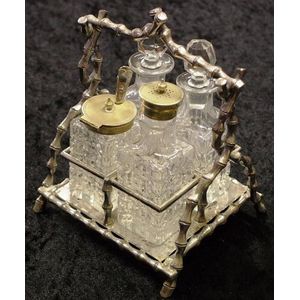Chippendale Style Inlaid Chair with Greek Key Legs
An Edwardian Chippendale style chair, the frame inlaid in a chevron and geometric pattern, raised on square section legs decorated in the Greek key pattern, cross stretcher base, velvet drop-in seat. 51 x 44 x 80 cm.
You must be a subscriber, and be logged in to view price and dealer details.
Subscribe Now to view actual auction price for this item
When you subscribe, you have the option of setting the currency in which to display prices to $Au, $US, $NZ or Stg.
This item has been sold, and the description, image and price are for reference purposes only.
- Edwardian - The Edwardian period of English furniture and decorative arts design is named for Edward VII (1841 ? 1910) who was King of the United Kingdom and the British Dominions and Emperor of India for the brief period from 1901 until his death in 1910. It follows the Victorian period, in turn was followed by the Art Nouveau and Art Deco styles. In Australia, designs of this period are also known as being in the Federation style.
- Greek Key - Moulding, found around cornices and sometimes tables, in the familiar Greek key pattern. The pattern was commonly used as brass inlay in furniture of the classical revival period
- Greek Key Pattern - The Greek key pattern is a decorative design that consists of continuous interlocking vertical and right-angled lines that form a repeating motif. It is also known as "Meander" or "Greek fret." The pattern is thought to have originated in ancient Greece, where it was used in various decorative arts, such as pottery, metalwork, and architectural elements. The Greek key design is widely used in a variety of contexts, including classical architecture, decorative arts, furniture, interior design and textiles. The pattern is considered timeless and classic, and its geometric simplicity makes it a popular choice for designers in many different fields.
- Chevron Motif - In jewellery, a chevron is a V-shaped pattern or design that is often used to create a bold and striking visual effect, and as a symbol of strength, power and protection.. It is a classic motif used in many different styles of jewellery and can be seen in various forms such as on a ring, earrings, bracelets, and necklaces. It can be created with precious or semi-precious stones, pearls, or enamel. It can be found in different forms such as engraved or inlaid or beaded.
In ceramics the pattern is often used in decorative pottery and porcelain pieces, such as vases, bowls, plates and figurines. The chevron pattern can be created by using different colored glazes or by hand-painting the design onto the piece. It is also commonly found in the form of embossing or intaglio in decorative ceramic objects. This pattern can be seen as a popular design choice in Art Deco and Art Nouveau style of ceramics.
This chevron pattern can also be found in many different types of furniture, such as tables, chairs, chests of drawers, and cabinets. A common place to find chevron pattern is in a herringbone pattern, which is made up of repeating V-shaped patterns. The chevron pattern can be created by using different types of wood, inlaying or by using different colors of stain. It is also commonly found in the form of a veneer. This pattern can be seen as a popular design choice in mid-century modern, Art Deco, and contemporary style furniture. - Stretcher - A horizontal rail which connects the legs of stools, chairs, tables and stands, to provide stabilisation of the legs. A stretcher table is any table with a stretcher base. The term is usually applied to substantial farmhouse tables, although many cabinetmaker's pieces, such as sofa tables, also have turned stretchers.
- Inlay - Decorative patterns inserted into the main body of a piece of furniture, generally in wood of contrasting colour and grain, though brass, ivory, ebony, shell and sometimes horn have been used. Inlay may consist of a panel of well figured timber inset into a cabinet door front, geometric patterns, or complex and stylized designs of flowers, swags of foliage, fruits and other motifs. As a general rule, in pieces where the carcase is constructed in the solid, the inlay is relatively simple such as stringing, cross banding and herringbone banding. Where more elaborate and decorative work was required veneer was used. Inlay has been fashionable from at least the latter half of the 17th century, when a variety of elaborate forms were developed
This item has been included into following indexes:
-
chairs, singles / pairs / threes, style or period
- Chippendale style 124
- Edwardian 149
Visually similar items

Antique silver plated cruet set. Height 20 cm approx
Sold by
in
for
You can display prices in $Au, $US, $NZ or Stg.

Silver plated coffee pot (1820-35)
Sold by
in
for
You can display prices in $Au, $US, $NZ or Stg.

Adolfe Fenyes (Hungarian, 1867-1945), young girl, oil on canvas, signed upper right: Fenyes A. [illeg.], 42.5 x 49 cm
Sold by
in
for
You can display prices in $Au, $US, $NZ or Stg.

Royal Doulton 'The Jovial Monk' figurine, HN2144, 19 cm high approx
Sold by
in
for
You can display prices in $Au, $US, $NZ or Stg.
